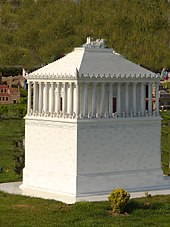Mausoleum at Halicarnassus
From Wikipedia, the free encyclopedia
(Redirected from Mausoleum of Halicarnassus)
| Mausoleum at Halicarnassus | |
|---|---|
| آرامگاه هالیکارناسوس | |

The ruins of the Mausoleum of Halicarnassus
| |
|
Location within Turkey
| |
| General information | |
| Status | In Ruins |
| Type | Mausoleum |
| Architectural style | Classical |
| Town or city | Halicarnassus, Achaemenid Empire (modern-day Bodrum, Turkey) |
| Country | Achaemenid Empire (nowadays located in Turkey) |
| Coordinates | 37°02′16″N 27°25′27″ECoordinates: 37°02′16″N 27°25′27″E |
| Opening | 351 BC |
| Demolished | 1494 AD |
| Client | Mausolus and Artemisia II of Caria |
| Owner | Artaxerxes III |
| Height | Approximately 45 m (148 ft) |
| Design and construction | |
| Architect | Satyros and Pythius of Priene |
| Other designers | Leochares, Bryaxis, Scopas andTimotheus |
The Mausoleum at Halicarnassus or Tomb of Mausolus [a] (Persian: آرامگاه هالیکارناسوس; Modern Greek: Μαυσωλείο της Αλικαρνασσού; Turkish: Halikarnas Mozolesi) was a tomb built between 353 and 350 BC at Halicarnassus (present Bodrum, Turkey) for Mausolus, a satrap in the Persian Empire, and Artemisia II of Caria, who was both his wife and his sister. The structure was designed by the Greek architects Satyros and Pythius of Priene.[1][2]
The Mausoleum was approximately 45 m (148 ft) in height, and the four sides were adorned with sculptural reliefs, each created by one of four Greek sculptors—Leochares, Bryaxis, Scopas of Paros and Timotheus.[3] The finished structure of the mausoleum was considered to be such an aesthetic triumph that Antipater of Sidonidentified it as one of his Seven Wonders of the Ancient World. It was destroyed by successive earthquakes from the 12th to the 15th century.[4][5][6]
The word mausoleum has now come to be used generically for an above-ground tomb.
Contents
[hide]Conquest[edit]
In the 4th century BCE, Halicarnassus was the capital of a small regional kingdom within the Achaemenid Persian Empire on the western coast of Asia Minor. In 377 BCE, the nominal ruler of the region, Hecatomnus of Milas, died and left the control of the kingdom to his son, Mausolus. Hecatomnus, a local satrap under the Persians, took control of several of the neighboring cities and districts. After Artemisia and Mausolus, he had several other daughters and sons: Ada (adoptive mother of Alexander the Great), Idrieus and Pixodarus. Mausolus extended its territory as far as the southwest coast of Anatolia. Artemisia and Mausolus ruled from Halicarnassus over the surrounding territory for 24 years. Mausolus, although descended from local people, spoke Greek and admired the Greek way of life and government. He founded many cities of Greek design along the coast and encouraged Greek democratic traditions[citation needed].
Halicarnassus[edit]
Mausolus decided to build a new capital; a city as safe from capture as it was magnificent to be seen. He chose the city of Halicarnassus. If Mausolus' ships blocked a small channel, they could keep all enemy warships out. His workmen deepened the city's harbor and used the dredged sand to make protecting breakwaters in front of the channel[citation needed]. On land they paved streets and squares, and built houses for ordinary citizens. And on one side of the harbor they built a massive fortified palace for Mausolus, positioned to have clear views out to sea and inland to the hills — places from where enemies could attack.
On land, the workmen also built walls and watchtowers, a Greek–style theatre and a temple to Ares — the Greek god of war.
Artemisia and Mausolus spent huge amounts of tax money to embellish the city. They commissioned statues, temples and buildings of gleaming marble. On a hill overlooking the city Artemisia planned to place a resting place for her body, and her husband's, after their death.
In 353 BC, Mausolus died, leaving Artemisia to rule alone. As a tribute to him, she decided to build him a tomb so famous that Mausolus's name is now the eponym for all stately tombs, in the word mausoleum. The construction was also so beautiful and unique it became one of the Seven Wonders of the Ancient World.
Artemisia lived for only two years after the death of her husband. The urns with their ashes were placed in the yet unfinished tomb. As a form of sacrifice ritual the bodies of a large number of dead animals were placed on the stairs leading to the tomb, and then the stairs were filled with stones and rubble, sealing the access. According to the historian Pliny the Elder, the craftsmen decided to stay and finish the work after the death of their patron "considering that it was at once a memorial of his own fame and of the sculptor's art."
Construction of the Mausoleum[edit]
Artemisia spared no expense in building the tomb. She sent messengers to Greece to find the most talented artists of the time. These included Scopas, the man who had supervised the rebuilding of the Temple of Artemis at Ephesus. The famous sculptors were (in the Vitruvius order): Leochares, Bryaxis, Scopas and Timotheus, as well as hundreds of other craftsmen.





No comments:
Post a Comment